Unveiling Natural and Semisynthetic Acylated Flavonoids: Chemistry and Biological Actions in the Context of Molecular Docking
Abstract
1. Introduction
2. Experimental Section
Molecular Docking Study on Enzymes Inhibitory Compounds
3. In Vitro Semi-Synthetic Acylation of Flavonoids and Their Main Actions
4. Occurrence of Natural Acylated Flavonoids in Planta
5. Stability and Light Resistance of Acylated Flavonoids
6. Pharmacokinetics of Acylated Flavonoids
7. Biological Effects of Natural Acylated Flavonoids
7.1. Hepatoprotective Action
7.2. Anti-Diabetic Action
7.3. Natural Enzyme Inhibitors
7.3.1. Acetyl and Butyrylcholinesterase Natural Inhibitors “Neuroprotective Action”
| Acylated Flavonoids | Plant Source | Biological Action | Reference |
|---|---|---|---|
| Caffeoyl acylated glycosides | Lathyrus digitatus Lathyrus cicero | High inhibitory effect on butyrylcholinestearse enzyme. | [63] |
| 7-O-glucosyl-6-arabinosyl-8-C-(6’’’-malonyl)-arabinosyl chrysoeriol (16), 7-O-glucosyl-6-C-(2’’-malonyl)-arabinosyl-8-C-arabinosyl chrysoeriol (17), 7-O-glucosyl-6-Cglucosyl-8-C-(2’’’-sinapoyl)glucosyl luteolin (18) | Spergularia rubra | Inhibitory effect on butyrylcholinestearse enzymes | [62] |
| Kaempferol 3-O-(6’’-O-E-p-coumaroyl)-β-glucopyranoside (19) Kaempferol 3-O-(3’’-O-E-p-coumaroyl)-(6’’-O-E-feruloyl)-β –glucopyranoside (20) ,Kaempferol 3-O-(3’’,6’’-di-O-E-p-coumaroyl)-β –glucopyranoside (21) | Stenochlaena palustris | -Strong inhibitory activity on acetylcholinesterase -Moderate anti-butyrylcholinesterase action | [64] |
| Quercetin-3-O-α-(6’’’-p-coumaroyl-glucosyl-β-1,2-rhamnoside),(22) Kaempferol 3-O-α-(6’’’-p-coumaroyl-glucosyl-β-1,2-rhamnoside)(23) | Ginkgo biloba | Neuroprotective action and anti-AD | [66] |
| Quercetin-3-O-(2’’-O-(6’’’-O-(p-hydroxy-trans-cinnamoyl)-β-D-glucosyl)-α-L-rhamnoside) (24) Kaempferol-3-O-(2’’-O-(6’’’-O-(p-hydroxy-trans-cinnamoyl)-β-D-glucosyl)-α-L-rhamnoside (25) | Ginkgo biloba | Increased dopamine and acetyl choline neurotransmitters alleviating cognitive properties | [67] |
| Kaempferol-3-O-β-D-[4’’’-E-p-coumaroyl-α-L-rhamnosyl(1 → 6)]-galactoside (26), Kaempferol-3-O-β-D-[4’’’-E-p-coumaroyl-α-L-rhamnosyl (1 → 6)]-(3’’-E-p-coumaroyl)-galactoside (27), Kaempferol-3-O-β-D-[4’’’-E-p-coumaroyl-α-L-rhamnosyl-(1 → 6)]-(4’’-E-p-coumaroyl)-galactoside (28) | Aerva javanica | Weak inhibitory activity against cholinesterase, butyryl esterase, and lipoxygenase enzymes | [65] |
| Quercetin-3-O-[2-O-(6-O-E-feruloyl)-β-D-glucopyranosyl]-β-D-galactopyranoside (29), Quercetin-3-O-[2-O-(6-O-E-feruloyl)-β-D-glucopyranosyl]-β-D-glucopyranoside (30), Kaempferol 3-O-[2-O-(6-O-E-feruloyl)-β-D-glucopyranosyl]-β-D-galactopyranoside (31) | Hedyotis diffusa Willd | Neuroprotective action on rat cortical cells injured by glutamate | [69] |
| 6’’’-(–)-phaseoylspinosin (32) 6’’’-(3’’’’, 4’’’’, 5’’’’-trimethoxyl)-(E)-cinnamoyl spinosin (33) 6’’’-(4’’’’-O-β-D-glucopyranosyl)-benzoyl-spinosin, (34) | Ziziphus mauritiana | Moderate inhibitory impact on acetylcholinesterase | [70] |
| Isoscutellarein-7-(2’’-allosyl)-glucoside monoacetylated (35), Isoscutellarein-7-(2’’-allosyl)-glucoside diacetylated (36), Isoscutellarein-4’-methyl ether-7-(2’’-allosyl)-glucoside monoacetylated (37), Hypolaetin-7-(2’’-allosyl)-glucoside monoacetylated (38), Hypolaetin-4’-methyl ether-7-(2’’-allosyl)-glucoside monoacetylated (39), Hypolaetin-4’-methyl ether-7-(2’’-allosyl)-glucoside diacetylated (40), | Galeopsis ladanum | Antioxidant, anticholinesterase activity, and neuroprotective | [71] |
7.3.2. α-Amylase and α-Glucosidase Enzyme Natural Inhibitors
| Acylated Flavonoids | Plant Source | Biological Action | Reference |
|---|---|---|---|
| 6’’-O-caffeoyl-hyperoside (41), 6’’-O-caffeoyl isoquercitrin (42), 6’’-O-caffeoyl-astragalin (43) | Spiraea salicifolia | Inhibitory effects on α-amylase, natural antidiabetic agent | [73] |
| 6-O-(E)-caffeoyl-2-O-β-D-glucopyranosyl-β-D-glucopyranoside (6-O-caffeoylsophorose) (44) | Red vinegar fermented with roots of purple-sweet potato enriched with peonidin-3-O-(2-O-(6-O-E-feruloyl-β-D-glucopyranosyl)-6-O-E-caffeoyl-β-D-glucopyranoside)-5-O-β-D-glucopyranoside) | Inhibitory effects on maltase and sucrase enzymes; no effect on α amylase; the acylated penoidin possessed an effective inhibitory action on α amylase | [76] |
| Linarin (45) Hispidulin-7-O-(4-O-acetyl-rutinoside)(46) | Zhumeria majdae | Treatment of stomach pain and dysmenorrhea Potential inhibitory action on α amylase | [77] |
| kaempferol-3-O-α-L-rhamnopyranoside 3’’,4’’-di-E-p-coumaric acid ester (47) Kaempferol-3-O-α-L-rhamnopyranoside-3’’-E,4’’-Z-di-p-coumaric acid ester (48) | Machilus philippinense Merr, | Potent α-glucosidase inhibition | [78] |
| Isoorientin 2’’-(E)-p-coumarate (49), Isoorientin 2”-O-(E)-sinapate (50), Isovitexin 2”-(E)-p-coumarate (51), Cosmosiin-6’’-(E)-ferulate (52), Cosmosiin 6’’-(E)-cinnamate (53) | Tinospora crispa Miers | Antidiabetic through activation of insulin signaling | [79] |
| Panasenoside A (54) (quercetin-4’-p-hydroxybenzoyl-3-O-(2’’-β-D-glucopyranosyl)-β-D-galactopyranoside) | Chinese Panax ginseng | Inhibitory activity against α-glucosidase | [80] |
| Cyanidin (55) Peonidine-3-O-(2-O-(6-O-E-Feruyl-β-D-glucopyranosyl)-6-O-E-Caffeoyl-β-D-glucopyranoside)-5-O-β-D-glucopyranoside (56) Pelargonidin-3-O-(2-O-(6-O-E-O-Caffeoyl-β-D-glucopyranosyl)-6-O-E-Caffeoyl-β-D-glucopyranoside)-5-O-β-D-glucopyranoside (57) | Ipomoea batatas cv. Ayamurasaki Pharbitis nil cv. | Hypoglycemic activity by inhibition of α-glucosidase | [81] |
| C6’’-acetylated C3-glycosides of delphinidine (58), malvinidin (59) and petunidin (60) types | Three cultivars of blueberry | Inhibition of α-glucosidase | [82] |
| Cyanidin-3-O-glucoside (61), Pelargonidin-3-O-glucoside (62), Peonidin-3-glucosides (63) and their corresponding malonyl esters “C6’ acylation with malonyl residue” | Zea Mays L. | Hypoglycemic activity through inhibition of α-glucosidase and improved insulin sensitivity in adipocytes resistant to insulin | [83] |
7.3.3. Aldose Reductase Enzyme Natural Inhibitors
7.3.4. Xanthine Oxidase Enzyme Natural Inhibitors
7.4. Sarco/Endoplasmic Reticulum Ca2+-ATPase Pump (SERCA1) Natural Inhibitors
7.5. Human Immunodeficiency Virus 1 (HIV-1) Integrase Enzyme Natural Inhibitors
7.6. Cardioprotective Activity
7.7. Vasorelaxant and Haematological Activity
7.8. Miscellaneous Activities
Wound Healing Activity
8. Molecular Docking Study of Selected Biologically Active Compounds in Natural Enzymes
9. Conclusions
Supplementary Materials
Author Contributions
Funding
Institutional Review Board Statement
Informed Consent Statement
Data Availability Statement
Conflicts of Interest
Sample Availability
References
- De Araújo, M.E.M.; Franco, Y.E.; Messias, M.C.; Longato, G.B.; Pamphile, J.A.; Carvalho, P.d.O. Biocatalytic synthesis of flavonoid esters by lipases and their biological benefits. Planta Med. 2017, 83, 7–22. [Google Scholar] [CrossRef] [PubMed]
- Wang, S.; Alseekh, S.; Fernie, A.R.; Luo, J. The structure and function of major plant metabolite modifications. Mol. Plant 2019, 12, 899–919. [Google Scholar] [CrossRef] [PubMed]
- Ullah, A.; Munir, S.; Badshah, S.L.; Khan, N.; Ghani, L.; Poulson, B.G.; Emwas, A.-H.; Jaremko, M. Important Flavonoids and Their Role as a Therapeutic Agent. Molecules 2020, 25, 5243. [Google Scholar] [CrossRef] [PubMed]
- Panche, A.; Diwan, A.; Chandra, S. Flavonoids: An overview. J. Nutr. Sci. 2016, 5, e47. [Google Scholar] [CrossRef]
- Chebil, L.; Anthoni, J.; Humeau, C.; Gerardin, C.; Engasser, J.-M.; Ghoul, M. Enzymatic acylation of flavonoids: Effect of the nature of the substrate, origin of lipase, and operating conditions on conversion yield and regioselectivity. J. Agric. Food Chem. 2007, 55, 9496–9502. [Google Scholar] [CrossRef]
- Braca, A.; Fico, G.; Morelli, I.; De Simone, F.; Tomè, F.; De Tommasi, N. Antioxidant and free radical scavenging activity of flavonol glycosides from different Aconitum species. J. Ethnopharmacol. 2003, 86, 63–67. [Google Scholar] [CrossRef]
- Xin, X.; Zhang, M.; Li, X.; Lai, F.; Zhao, G. Biocatalytic synthesis of acylated derivatives of troxerutin: Their bioavailability and antioxidant properties in vitro. Microb. Cell Factories 2018, 17, 130. [Google Scholar] [CrossRef]
- Julkunen-Tiitto, R.; Nenadis, N.; Neugart, S.; Robson, M.; Agati, G.; Vepsäläinen, J.; Zipoli, G.; Nybakken, L.; Winkler, B.; Jansen, M.A. Assessing the response of plant flavonoids to UV radiation: An overview of appropriate techniques. Phytochem. Rev. 2015, 14, 273–297. [Google Scholar] [CrossRef]
- Cheung, J.; Rudolph, M.J.; Burshteyn, F.; Cassidy, M.S.; Gary, E.N.; Love, J.; Franklin, M.C.; Height, J.J. Structures of human acetylcholinesterase in complex with pharmacologically important ligands. J. Med. Chem. 2012, 55, 10282–10286. [Google Scholar] [CrossRef]
- Nachon, F.; Carletti, E.; Ronco, C.; Trovaslet, M.; Nicolet, Y.; Jean, L.; Renard, P.-Y. Crystal structures of human cholinesterases in complex with huprine W and tacrine: Elements of specificity for anti-Alzheimer’s drugs targeting acetyl-and butyryl-cholinesterase. J Biochem. J. 2013, 453, 393–399. [Google Scholar] [CrossRef]
- Williams, L.K.; Zhang, X.; Caner, S.; Tysoe, C.; Nguyen, N.T.; Wicki, J.; Williams, D.E.; Coleman, J.; McNeill, J.H.; Yuen, V. The amylase inhibitor montbretin A reveals a new glycosidase inhibition motif. J Nat. Chem. Biol. 2015, 11, 691–696. [Google Scholar] [CrossRef] [PubMed]
- Sim, L.; Quezada-Calvillo, R.; Sterchi, E.E.; Nichols, B.L.; Rose, D.R. Human intestinal maltase–glucoamylase: Crystal structure of the N-terminal catalytic subunit and basis of inhibition and substrate specificity. J. Mol. Biol. 2008, 375, 782–792. [Google Scholar] [CrossRef] [PubMed]
- Zheng, X.; Zhang, L.; Zhai, J.; Chen, Y.; Luo, H.; Hu, X. The molecular basis for inhibition of sulindac and its metabolites towards human aldose reductase. FEBS Lett. 2012, 586, 55–59. [Google Scholar] [CrossRef] [PubMed]
- Goldgur, Y.; Craigie, R.; Cohen, G.H.; Fujiwara, T.; Yoshinaga, T.; Fujishita, T.; Sugimoto, H.; Endo, T.; Murai, H.; Davies, D.R. Structure of the HIV-1 integrase catalytic domain complexed with an inhibitor: A platform for antiviral drug design. Proc. Natl. Acad. Sci. USA 1999, 96, 13040–13043. [Google Scholar] [CrossRef] [PubMed]
- Biely, P.; Cziszárová, M.; Wong, K.K.; Fernyhough, A. Enzymatic acylation of flavonoid glycosides by a carbohydrate esterase of family 16. Biotechnol. Lett. 2014, 36, 2249–2255. [Google Scholar] [CrossRef]
- Ardhaoui, M.; Falcimaigne, A.; Ognier, S.; Engasser, J.; Moussou, P.; Pauly, G.; Ghoul, M. Effect of acyl donor chain length and substitutions pattern on the enzymatic acylation of flavonoids. J. Biotechnol. 2004, 110, 265–272. [Google Scholar] [CrossRef]
- De Oliveira, E.B.; Humeau, C.; Chebil, L.; Maia, E.R.; Dehez, F.; Maigret, B.; Ghoul, M.; Engasser, J.-M. A molecular modelling study to rationalize the regioselectivity in acylation of flavonoid glycosides catalyzed by Candida antarctica lipase B. J. Mol. Catal. B Enzym. 2009, 59, 96–105. [Google Scholar] [CrossRef]
- Viskupicova, J.; Danihelova, M.; Ondrejovic, M.; Liptaj, T.; Sturdik, E. Lipophilic rutin derivatives for antioxidant protection of oil-based foods. Food Chem. 2010, 123, 45–50. [Google Scholar] [CrossRef]
- Kopustinskiene, D.M.; Jakstas, V.; Savickas, A.; Bernatoniene, J. Flavonoids as anticancer agents. Nutrients 2020, 12, 457. [Google Scholar] [CrossRef]
- Sudan, S.; Rupasinghe, H.V. Antiproliferative activity of long chain acylated esters of quercetin-3-O-glucoside in hepatocellular carcinoma HepG2 cells. J. Exp. Biol. 2015, 240, 1452–1464. [Google Scholar] [CrossRef]
- Harborne, J.B.; Williams, C.A. Advances in flavonoid research since 1992. Phytochemistry 2000, 55, 481–504. [Google Scholar] [CrossRef]
- Górniak, I.; Bartoszewski, R.; Króliczewski, J. Comprehensive review of antimicrobial activities of plant flavonoids. Phytochem. Rev. 2019, 18, 241–272. [Google Scholar] [CrossRef]
- Lin, S.F.; Lin, Y.-H.; Lin, M.; Kao, Y.-F.; Wang, R.-W.; Teng, L.-W.; Chuang, S.-H.; Chang, J.-M.; Yuan, T.-T.; Fu, K.C. Synthesis and structure–activity relationship of 3-O-acylated (–)-epigallocatechins as 5α-reductase inhibitors. Eur. J. Med. Chem. 2010, 45, 6068–6076. [Google Scholar] [CrossRef] [PubMed]
- Huang, P.; Yang, X.-D.; Chen, S.-D.; Xiao, Q. The association between Parkinson’s disease and melanoma: A systematic review and meta-analysis. Transl. Neurodegener. 2015, 4, 21. [Google Scholar] [CrossRef] [PubMed]
- Bhullar, K.S.; Warnakulasuriya, S.N.; Rupasinghe, H.V. Biocatalytic synthesis, structural elucidation, antioxidant capacity and tyrosinase inhibition activity of long chain fatty acid acylated derivatives of phloridzin and isoquercitrin. Bioorg. Med. Chem. 2013, 21, 684–692. [Google Scholar]
- Llorach, R.; Gil-Izquierdo, A.; Ferreres, F.; Tomás-Barberán, F.A.; Chemistry, F. HPLC-DAD-MS/MS ESI characterization of unusual highly glycosylated acylated flavonoids from cauliflower (Brassica oleracea L. var. botrytis) agroindustrial byproducts. J. Agric. Food Chem. 2003, 51, 3895–3899. [Google Scholar] [CrossRef]
- Ferreres, F.; Valentão, P.; Llorach, R.; Pinheiro, C.; Cardoso, L.; Pereira, J.A.; Sousa, C.; Seabra, R.M.; Andrade, P.B. Phenolic compounds in external leaves of tronchuda cabbage (Brassica oleracea L. var. costata DC). J. Agric. Food Chem. 2005, 53, 2901–2907. [Google Scholar] [CrossRef]
- Ahmad, M.Z.; Li, P.; Wang, J.; Rehman, N.U.; Zhao, J. Isoflavone malonyltransferases GmIMaT1 and GmIMaT3 differently modify isoflavone glucosides in soybean (Glycine max) under various stresses. J. Front. Plant Sci. 2017, 8, 735. [Google Scholar] [CrossRef]
- Liazid, A.; Barbero, G.F.; Azaroual, L.; Palma, M.; Barroso, C.G. Stability of anthocyanins from red grape skins under pressurized liquid extraction and ultrasound-assisted extraction conditions. Molecules 2014, 19, 21034–21043. [Google Scholar] [CrossRef]
- Giusti, M.M.; Wrolstad, R.E. Acylated anthocyanins from edible sources and their applications in food systems. Biochem. Eng. 2003, 14, 217–225. [Google Scholar] [CrossRef]
- Oh, Y.; Lee, J.; Yoon, S.; Oh, C.; Choi, D.S.; Choe, E.; Jung, M. Characterization and quantification of anthocyanins in grape juices obtained from the grapes cultivated in Korea by HPLC/DAD, HPLC/MS, and HPLC/MS/MS. J. Food Sci. 2008, 73, C378–C389. [Google Scholar] [CrossRef] [PubMed]
- Liang, N.-N.; Zhu, B.-Q.; Han, S.; Wang, J.-H.; Pan, Q.-H.; Reeves, M.J.; Duan, C.-Q.; He, F. Regional characteristics of anthocyanin and flavonol compounds from grapes of four Vitis vinifera varieties in five wine regions of China. Food Res. Int. 2014, 64, 264–274. [Google Scholar] [CrossRef] [PubMed]
- Favre, G.; González-Neves, G.; Piccardo, D.; Gómez-Alonso, S.; Pérez-Navarro, J.; Hermosín-Gutiérrez, I. New acylated flavonols identified in Vitis vinifera grapes and wines. Food Res. Int. 2018, 112, 98–107. [Google Scholar] [CrossRef] [PubMed]
- Ferrandino, A.; Carra, A.; Rolle, L.; Schneider, A.; Schubert, A. Profiling of hydroxycinnamoyl tartrates and acylated anthocyanins in the skin of 34 Vitis vinifera genotypes. J. Agric. Food Chem. 2012, 60, 4931–4945. [Google Scholar] [CrossRef] [PubMed]
- De Beer, D.; Joubert, E.; Marais, J.; Van Schalkwyk, D.; Manley, M. Climatic region and vine structure: Effect on Pinotage wine phenolic composition, total antioxidant capacity and colour. S. Afr. J. Enol. Vitic. 2006, 27, 151–166. [Google Scholar] [CrossRef]
- Islam, M.S.; Yoshimoto, M.; Terahara, N.; YAMAKAWA, O. Anthocyanin compositions in sweetpotato (Ipomoea batatas L.) leaves. Biosci. Biotechnol. Biochem. 2002, 66, 2483–2486. [Google Scholar] [CrossRef]
- He, W.; Zeng, M.; Chen, J.; Jiao, Y.; Niu, F.; Tao, G.; Zhang, S.; Qin, F.; He, Z. Identification and quantitation of anthocyanins in purple-fleshed sweet potatoes cultivated in China by UPLC-PDA and UPLC-QTOF-MS/MS. J. Agric. Food Chem. 2016, 64, 171–177. [Google Scholar] [CrossRef]
- Tian, Q.; Konczak, I.; Schwartz, S.J. Probing anthocyanin profiles in purple sweet potato cell line (Ipomoea batatas L. Cv. Ayamurasaki) by high-performance liquid chromatography and electrospray ionization tandem mass spectrometry. J. Agric. Food Chem. 2005, 53, 6503–6509. [Google Scholar] [CrossRef]
- Oliveira, H.; Basílio, N.; Pina, F.; Fernandes, I.; de Freitas, V.; Mateus, N. Purple-fleshed sweet potato acylated anthocyanins: Equilibrium network and photophysical properties. Food Chem. 2019, 288, 386–394. [Google Scholar] [CrossRef]
- Majid, M.; Farhan, A.; Asad, M.I.; Khan, M.R.; Hassan, S.S.u.; Haq, I.-u.; Bungau, S. An Extensive Pharmacological Evaluation of New Anti-Cancer Triterpenoid (Nummularic Acid) from Ipomoea batatas through In Vitro, In Silico, and In Vivo Studies. Molecules 2022, 27, 2474. [Google Scholar] [CrossRef]
- Gallate, G.-J.D.E. Is the Most Effective Cancer Chemopreventive Polyphenol in Green Tea/Guang-Jian Du et al. Nutrents 2012, 4, 1679–1691. [Google Scholar]
- Teles, Y.C.; Souza, M.S.R.; Souza, M.D.F.V.d.J.M. Sulphated flavonoids: Biosynthesis, structures, and biological activities. Molecules 2018, 23, 480. [Google Scholar] [CrossRef] [PubMed]
- Ku, S.-K.; Kim, T.H.; Bae, J.-S. Anticoagulant activities of persicarin and isorhamnetin. J. Vasc. Pharmacol. 2013, 58, 272–279. [Google Scholar] [CrossRef] [PubMed]
- Rasheed, D.M.; Porzel, A.; Frolov, A.; El Seedi, H.R.; Wessjohann, L.A.; Farag, M.A. Comparative analysis of Hibiscus sabdariffa (roselle) hot and cold extracts in respect to their potential for α-glucosidase inhibition. Food Chem. 2018, 250, 236–244. [Google Scholar] [CrossRef] [PubMed]
- McDougall, G.J.; Fyffe, S.; Dobson, P.; Stewart, D. Anthocyanins from red cabbage–stability to simulated gastrointestinal digestion. Phytochemistry 2007, 68, 1285–1294. [Google Scholar] [CrossRef]
- Xu, J.; Su, X.; Lim, S.; Griffin, J.; Carey, E.; Katz, B.; Tomich, J.; Smith, J.S.; Wang, W. Characterisation and stability of anthocyanins in purple-fleshed sweet potato P40. Food Chem. 2015, 186, 90–96. [Google Scholar] [CrossRef] [PubMed]
- Nakajima, N.; Sugimoto, M.; Yokoi, H.; Tsuji, H.; Ishihara, K. Comparison of acylated plant pigments: Light-resistance and radical-scavenging ability. Biosci. Biotechnol. Biochem. 2003, 67, 1828–1831. [Google Scholar] [CrossRef] [PubMed][Green Version]
- Fernandez-Aulis, F.; Torres, A.; Sanchez-Mendoza, E.; Cruz, L.; Navarro-Ocana, A. New acylated cyanidin glycosides extracted from underutilized potential sources: Enzymatic synthesis, antioxidant activity and thermostability. Food Chem. 2020, 309, 125796. [Google Scholar] [CrossRef] [PubMed]
- Wu, X.; Pittman, H.E., III; Prior, R.L. Pelargonidin is absorbed and metabolized differently than cyanidin after marionberry consumption in pigs. J. Nutr. 2004, 134, 2603–2610. [Google Scholar] [CrossRef]
- Felgines, C.; Talavéra, S.; Texier, O.; Besson, C.; Fogliano, V.; Lamaison, J.-L.; la Fauci, L.; Galvano, G.; Rémésy, C.; Galvano, F. Absorption and metabolism of red orange juice anthocyanins in rats. Br. J. Nutr. 2006, 95, 898–904. [Google Scholar] [CrossRef]
- Charron, C.S.; Kurilich, A.C.; Clevidence, B.A.; Simon, P.W.; Harrison, D.J.; Britz, S.J.; Baer, D.J.; Novotny, J.A. Bioavailability of anthocyanins from purple carrot juice: Effects of acylation and plant matrix. J. Agric. Food Chem. 2009, 57, 1226–1230. [Google Scholar] [CrossRef] [PubMed]
- Charron, C.S.; Clevidence, B.A.; Britz, S.J.; Novotny, J.A. Effect of dose size on bioavailability of acylated and nonacylated anthocyanins from red cabbage (Brassica oleracea L. Var. capitata). J. Agric. Food Chem. 2007, 55, 5354–5362. [Google Scholar] [CrossRef] [PubMed]
- Marzouk, M.; Soliman, F.; Shehata, I.; Rabee, M.; Fawzy, G. Flavonoids and biological activities of Jussiaea repens. J. Nat. Prod. Res. 2007, 21, 436–443. [Google Scholar] [CrossRef] [PubMed]
- Suda, I.; Ishikawa, F.; Hatakeyama, M.; Miyawaki, M.; Kudo, T.; Hirano, K.; Ito, A.; Yamakawa, O.; Horiuchi, S. Intake of purple sweet potato beverage affects on serum hepatic biomarker levels of healthy adult men with borderline hepatitis. Eur. J. Clin. Nutr. 2008, 62, 60–67. [Google Scholar] [CrossRef]
- Esatbeyoglu, T.; Rodríguez-Werner, M.; Schlösser, A.; Winterhalter, P.; Rimbach, G. Fractionation, enzyme inhibitory and cellular antioxidant activity of bioactives from purple sweet potato (Ipomoea batatas). Food Chem. 2017, 221, 447–456. [Google Scholar] [CrossRef]
- Chin, Y.-W.; Lim, S.W.; Kim, Y.C.; Choi, S.Z.; Lee, K.R.; Kim, J. Hepatoprotective flavonol glycosides from the aerial parts of Rodgersia podophylla. Planta Med. 2004, 70, 576–577. [Google Scholar] [CrossRef]
- Elshamy, A.I.; El-Shazly, M.; Yassine, Y.M.; El-Bana, M.A.; Farrag, A.-R.; Nassar, M.I.; Singab, A.N.; Noji, M.; Umeyama, A. Phenolic Constituents, Anti-Inflammatory and Antidiabetic Activities of Cyperus laevigatus L. Pharmacogn. J. 2017, 9, 828–833. [Google Scholar] [CrossRef]
- Strugała, P.; Dzydzan, O.; Brodyak, I.; Kucharska, A.Z.; Kuropka, P.; Liuta, M.; Kaleta-Kuratewicz, K.; Przewodowska, A.; Michałowska, D.; Gabrielska, J. Antidiabetic and antioxidative potential of the blue Congo variety of purple potato extract in streptozotocin-induced diabetic rats. Molecules 2019, 24, 3126. [Google Scholar] [CrossRef]
- Jokioja, J.; Linderborg, K.M.; Kortesniemi, M.; Nuora, A.; Heinonen, J.; Sainio, T.; Viitanen, M.; Kallio, H.; Yang, B. Anthocyanin-rich extract from purple potatoes decreases postprandial glycemic response and affects inflammation markers in healthy men. Food Chem. 2020, 310, 125797. [Google Scholar] [CrossRef]
- Yoshikawa, M.; Wang, T.; Morikawa, T.; Xie, H.; Matsuda, H. Bioactive constituents from Chinese natural medicines. XXIV. Hypoglycemic effects of Sinocrassula indica in sugar-loaded rats and genetically diabetic KK-Ay mice and structures of new acylated flavonol glycosides, sinocrassosides A1, A2, B1, and B2. Chem. Pharm. Bull. 2007, 55, 1308–1315. [Google Scholar] [CrossRef]
- Overall, J.; Bonney, S.A.; Wilson, M.; Beermann, A.; Grace, M.H.; Esposito, D.; Lila, M.A.; Komarnytsky, S. Metabolic effects of berries with structurally diverse anthocyanins. Int. J. Mol. Sci. 2017, 18, 422. [Google Scholar] [CrossRef] [PubMed]
- Oliveira, A.P.; Matos, R.P.; Silva, S.T.; Andrade, P.B.; Ferreres, F.; Gil-Izquierdo, A.; Meireles, S.; Brandão, T.M.; Valentão, P. A new iced tea base herbal beverage with Spergularia rubra extract: Metabolic profile stability and in vitro enzyme inhibition. J. Agric. Food Chem. 2013, 61, 8650–8656. [Google Scholar] [CrossRef] [PubMed]
- Llorent-Martínez, E.; Ortega-Barrales, P.; Zengin, G.; Mocan, A.; Simirgiotis, M.; Ceylan, R.; Uysal, S.; Aktumsek, A. Evaluation of antioxidant potential, enzyme inhibition activity and phenolic profile of Lathyrus cicera and Lathyrus digitatus: Potential sources of bioactive compounds for the food industry. Food Chem. Toxicol. 2017, 107, 609–619. [Google Scholar] [CrossRef] [PubMed]
- Chear, N.J.-Y.; Khaw, K.-Y.; Murugaiyah, V.; Lai, C.-S. Cholinesterase inhibitory activity and chemical constituents of Stenochlaena palustris fronds at two different stages of maturity. J. Food Drug Anal. 2016, 24, 358–366. [Google Scholar] [CrossRef] [PubMed]
- Mussadiq, S.; Riaz, N.; Saleem, M.; Ashraf, M.; Ismail, T.; Jabbar, A. New acylated flavonoid glycosides from flowers of Aerva javanica. J. Asian Nat. Prod. Res. 2013, 15, 708–716. [Google Scholar] [CrossRef]
- Xie, H.; Wang, J.-R.; Yau, L.-F.; Liu, Y.; Liu, L.; Han, Q.-B.; Zhao, Z.; Jiang, Z.-H. Quantitative analysis of the flavonoid glycosides and terpene trilactones in the extract of Ginkgo biloba and evaluation of their inhibitory activity towards fibril formation of β-amyloid peptide. Molecules 2014, 19, 4466–4478. [Google Scholar] [CrossRef]
- Gargouri, B.; Carstensen, J.; Bhatia, H.S.; Huell, M.; Dietz, G.P.; Fiebich, B.L. Anti-neuroinflammatory effects of Ginkgo biloba extract EGb761 in LPS-activated primary microglial cells. Phytomedicine 2018, 44, 45–55. [Google Scholar] [CrossRef]
- Kehr, J.; Yoshitake, S.; Ijiri, S.; Koch, E.; Nöldner, M.; Yoshitake, T. Ginkgo biloba leaf extract (EGb 761®) and its specific acylated flavonol constituents increase dopamine and acetylcholine levels in the rat medial prefrontal cortex: Possible implications for the cognitive enhancing properties of EGb 761®. Int. Psychogeriatr. 2012, 24, S25–S34. [Google Scholar] [CrossRef]
- Kim, Y.; Park, E.J.; Kim, J.; Kim, Y.-B.; Kim, S.R.; Kim, Y.C. Neuroprotective constituents from Hedyotis diffusa. J. Nat. Prod. 2001, 64, 75–78. [Google Scholar] [CrossRef]
- Wang, B.; Zhu, H.-T.; Wang, D.; Yang, C.-R.; Xu, M.; Zhang, Y.-J. New spinosin derivatives from the seeds of Ziziphus mauritiana. Nat. Prod. Bioprospect. 2013, 3, 93–98. [Google Scholar] [CrossRef]
- Uriarte-Pueyo, I.; Calvo, M.I. Structure–activity relationships of acetylated flavone glycosides from Galeopsis ladanum L. (Lamiaceae). Food Chem. 2010, 120, 679–683. [Google Scholar] [CrossRef]
- Bagli, E.; Goussia, A.; Moschos, M.M.; Agnantis, N.; Kitsos, G. Natural compounds and neuroprotection: Mechanisms of action and novel delivery systems. J. Vivo 2016, 30, 535–547. [Google Scholar]
- Kashchenko, N.; Chirikova, N.; Olennikov, D. Acylated Flavonoids from Spiraea Genus as Inhibitors of α-Amylase. Russ. J. Bioorg. Chem. 2018, 44, 876–886. [Google Scholar] [CrossRef]
- Hua, F.; Zhou, P.; Wu, H.; Chu, G.; Xie, Z.; Bao, G. Inhibition of flavonoid glycosides from Lu’an GuaPian tea on α-glucosidase and α-amylase: Molecular docking and interaction mechanism. Food Funct. 2018, 9, 4173–4183. [Google Scholar] [CrossRef] [PubMed]
- Terahara, N.; Matsui, T.; Minoda, K.; Nasu, K.; Kikuchi, R.; Fukui, K.; Ono, H.; Matsumoto, K. Functional new acylated sophoroses and deglucosylated anthocyanins in a fermented red vinegar. J. Agric. Food Chem. 2009, 57, 8331–8338. [Google Scholar] [CrossRef]
- Matsui, T.; Ebuchi, S.; Fukui, K.; Matsugano, K.; Terahara, N.; Matsumoto, K. Biochemistry, Caffeoylsophorose, a new natural α-glucosidase inhibitor, from red vinegar by fermented purple-fleshed sweet potato. Biosci. Biotechnol. 2004, 68, 2239–2246. [Google Scholar] [CrossRef]
- Mirshafie, B.; Mokhber-Dezfouli, N.; Manayi, A.; Saeidnia, S.; Ajani, Y.; Gohari, A.R. Alpha-amylase inhibitory activity and phytochemical study of Zhumeria majdae Rech. f. and Wendelbo. Pharmacogn. Res. 2015, 7, 309. [Google Scholar]
- Lee, S.-S.; Lin, H.-C.; Chen, C.-K. Acylated flavonol monorhamnosides, α-glucosidase inhibitors, from Machilus philippinensis. Phytochemistry 2008, 69, 2347–2353. [Google Scholar] [CrossRef]
- Chang, C.-C.; Ho, S.L.; Lee, S.-S. Acylated glucosylflavones as α-glucosidase inhibitors from Tinospora crispa leaf. Bioorg. Med. Chem. 2015, 23, 3388–3396. [Google Scholar] [CrossRef]
- Li, K.; Li, S.; Xu, F.; Cao, G.; Gong, X. A novel acylated quercetin glycoside and compounds of inhibitory effects on α-glucosidase from Panax ginseng flower buds. Nat. Prod. Res. 2020, 34, 2559–2565. [Google Scholar] [CrossRef]
- Matsui, T.; Ueda, T.; Oki, T.; Sugita, K.; Terahara, N.; Matsumoto, K. α-Glucosidase inhibitory action of natural acylated anthocyanins. 2. α-Glucosidase inhibition by isolated acylated anthocyanins. J. Agric. Food Chem. 2001, 49, 1952–1956. [Google Scholar] [CrossRef] [PubMed]
- Wu, Y.; Zhou, Q.; Chen, X.-y.; Li, X.; Wang, Y.; Zhang, J.-L. Comparison and screening of bioactive phenolic compounds in different blueberry cultivars: Evaluation of anti-oxidation and α-glucosidase inhibition effect. Food Res. Int. 2017, 100, 312–324. [Google Scholar] [CrossRef] [PubMed]
- Zhang, Q.; de Mejia, E.G.; Luna-Vital, D.; Tao, T.; Chandrasekaran, S.; Chatham, L.; Juvik, J.; Singh, V.; Kumar, D. Relationship of phenolic composition of selected purple maize (Zea mays L.) genotypes with their anti-inflammatory, anti-adipogenic and anti-diabetic potential. Food Chem. 2019, 289, 739–750. [Google Scholar] [CrossRef] [PubMed]
- Güvenç, A.; Okada, Y.; Akkol, E.K.; Duman, H.; Okuyama, T.; Çalış, İ. Investigations of anti-inflammatory, antinociceptive, antioxidant and aldose reductase inhibitory activities of phenolic compounds from Sideritis brevibracteata. Food Chem. 2010, 118, 686–692. [Google Scholar] [CrossRef]
- Nakamura, S.; Fujimoto, K.; Matsumoto, T.; Ohta, T.; Ogawa, K.; Tamura, H.; Matsuda, H.; Yoshikawa, M. Structures of acylated sucroses and an acylated flavonol glycoside and inhibitory effects of constituents on aldose reductase from the flower buds of Prunus mume. J. Nat. Med. 2013, 67, 799–806. [Google Scholar] [CrossRef]
- Jiao, R.H.; Ge, H.M.; Shi, D.H.; Tan, R.X. An Apigenin-Derived Xanthine Oxidase Inhibitor from Palhinhaea c ernua. J. Nat. Prod. 2006, 69, 1089–1091. [Google Scholar] [CrossRef]
- Zhang, P.; Chan, W.; Ang, I.L.; Wei, R.; Lam, M.M.; Lei, K.M.; Poon, T.C. Revisiting fragmentation reactions of protonated α-amino acids by high-resolution electrospray ionization tandem mass spectrometry with collision-induced dissociation. Sci. Rep. 2019, 9, 6453. [Google Scholar] [CrossRef]
- Zhang, Z.-c.; Zhou, Q.; Yang, Y.; Wang, Y.; Zhang, J.-l. Highly acylated anthocyanins from purple sweet potato (Ipomoea batatas L.) alleviate hyperuricemia and kidney inflammation in hyperuricemic mice: Possible attenuation effects on allopurinol. J. Agric. Food Chem. 2019, 67, 6202–6211. [Google Scholar] [CrossRef]
- Viskupicova, J.; Majekova, M.; Horakova, L. Inhibition of the sarco/endoplasmic reticulum Ca 2+-ATPase (SERCA1) by rutin derivatives. J. Muscle Res. Cell Motil. 2015, 36, 183–194. [Google Scholar] [CrossRef]
- Kim, H.J.; Woo, E.-R.; Shin, C.-G.; Park, H. A new flavonol glycoside gallate ester from Acer okamotoanum and its inhibitory activity against human immunodeficiency virus-1 (HIV-1) integrase. J. Nat. Prod. 1998, 61, 145–148. [Google Scholar] [CrossRef]
- Wang, Y.; Xie, X.; Liu, L.; Zhang, H.; Ni, F.; Wen, J.; Wu, Y.; Wang, Z.; Xiao, W. Four new flavonol glycosides from the leaves of Ginkgo biloba. Nat. Prod. Res. 2019, 35, 2520–2525. [Google Scholar] [CrossRef]
- Feng, Z.-Q.; Wang, Y.-Y.; Guo, Z.-R.; Chu, F.-M.; Sun, P.-Y. The synthesis of puerarin derivatives and their protective effect on the myocardial ischemia and reperfusion injury. J. Asian Nat. Prod. Res. 2010, 12, 843–850. [Google Scholar] [CrossRef] [PubMed]
- Lee, S.; Chung, S.-C.; Lee, S.-H.; Park, W.; Oh, I.; Mar, W.; Shin, J.; Oh, K.-B. Acylated kaempferol glycosides from Laurus nobilis leaves and their inhibitory effects on Na+/K+-adenosine triphosphatase. Biol. Pharm. Bull. 2012, 35, 428–432. [Google Scholar] [CrossRef] [PubMed][Green Version]
- Chen, G.-H.; Li, Y.-C.; Lin, N.-H.; Kuo, P.-C.; Tzen, J.T. Characterization of vasorelaxant principles from the needles of Pinus morrisonicola Hayata. Molecules 2018, 23, 86. [Google Scholar] [CrossRef] [PubMed]
- Tsutsumi, A.; Horikoshi, Y.; Fushimi, T.; Saito, A.; Koizumi, R.; Fujii, Y.; Hu, Q.Q.; Hirota, Y.; Aizawa, K.; Osakabe, N. Acylated anthocyanins derived from purple carrot (Daucus carota L.) induce elevation of blood flow in rat cremaster arteriole. Food Funct. 2019, 10, 1726–1735. [Google Scholar] [CrossRef]
- Guglielmone, H.A.; Agnese, A.M.; Montoya, S.C.N.; Cabrera, J.L. Inhibitory effects of sulphated flavonoids isolated from Flaveria bidentis on platelet aggregation. Thromb. Res. 2005, 115, 495–502. [Google Scholar] [CrossRef]
- Duan, Y.; Sun, N.; Xue, M.; Wang, X.; Yang, H. Synthesis of regioselectively acylated quercetin analogues with improved antiplatelet activity. Mol. Med. Rep. 2017, 16, 9735–9740. [Google Scholar] [CrossRef]
- Clericuzio, M.; Tinello, S.; Burlando, B.; Ranzato, E.; Martinotti, S.; Cornara, L.; La Rocca, A. Flavonoid oligoglycosides from Ophioglossum vulgatum L. having wound healing properties. Planta Med. 2012, 78, 1639–1644. [Google Scholar] [CrossRef]
- Kuzu, B.; Tan, M.; Taslimi, P.; Gülçin, İ.; Taşpınar, M.; Menges, N. Mono-or di-substituted imidazole derivatives for inhibition of acetylcholine and butyrylcholine esterases. Bioorg. Chem. 2019, 86, 187–196. [Google Scholar] [CrossRef]
- El-Sayed, N.F.; El-Hussieny, M.; Ewies, E.F.; Fouad, M.A.; Boulos, L.S. New phosphazine and phosphazide derivatives as multifunctional ligands targeting acetylcholinesterase and β-Amyloid aggregation for treatment of Alzheimer’s disease. Bioorg. Chem. 2020, 95, 103499. [Google Scholar] [CrossRef]
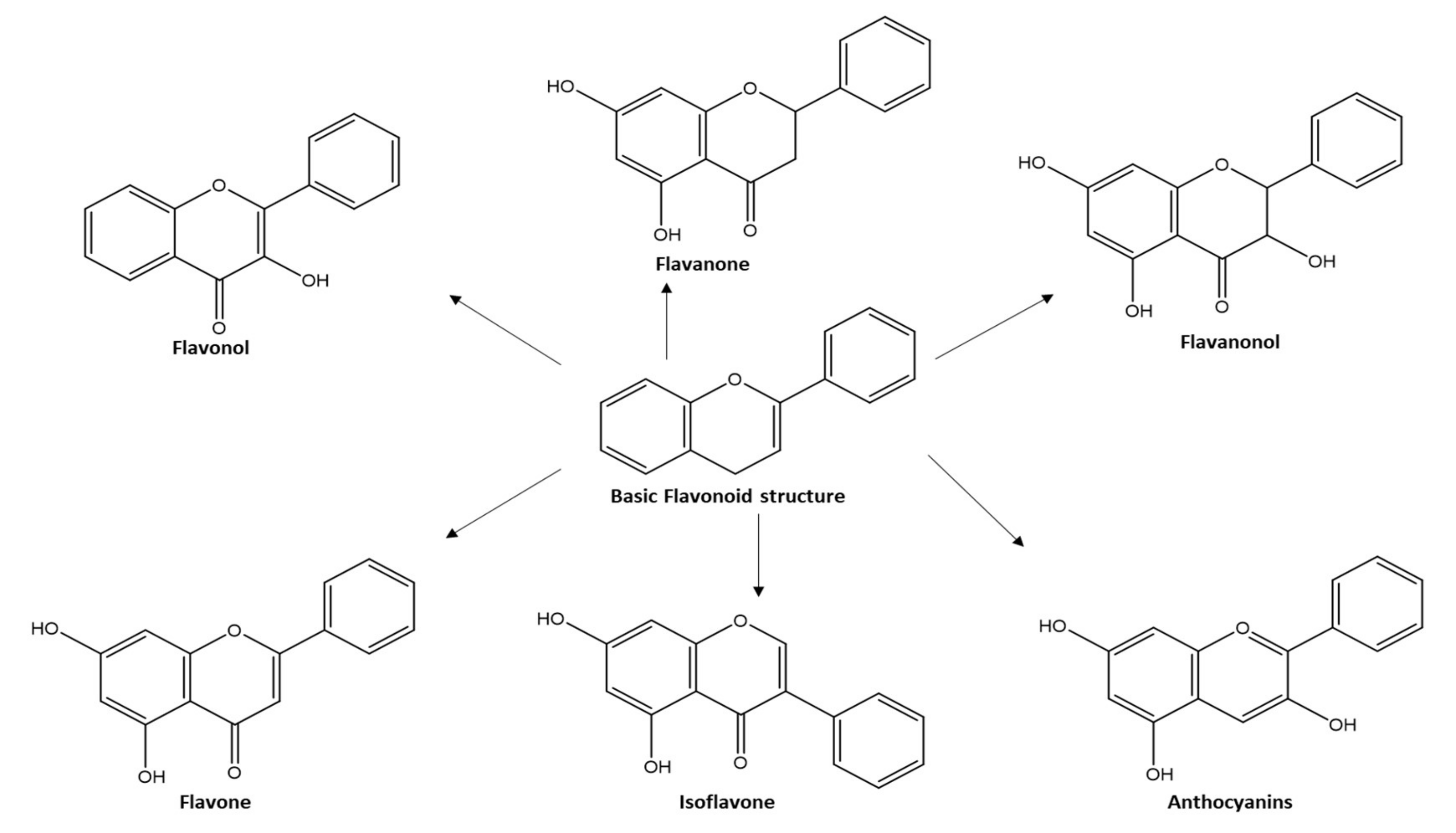
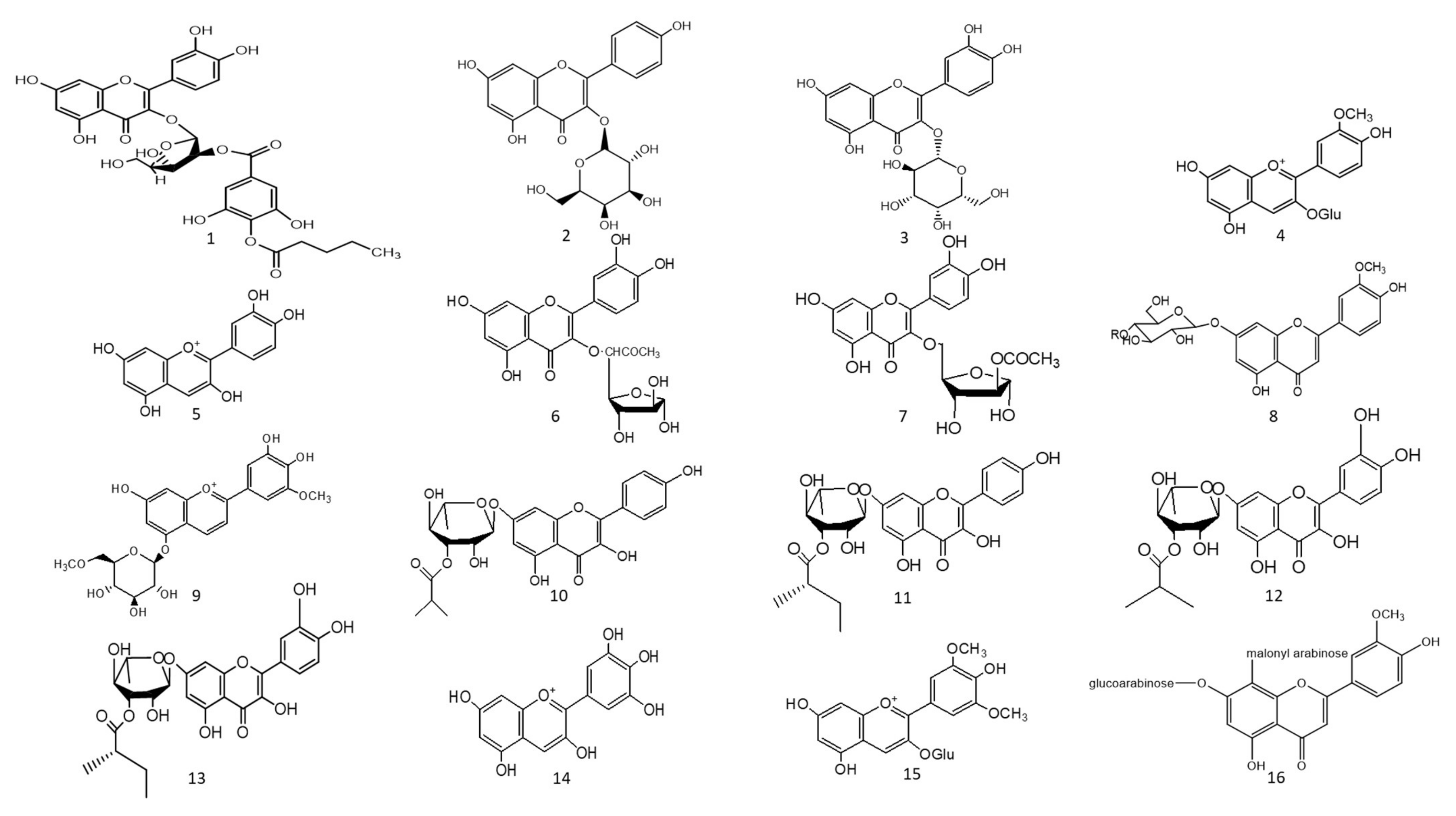
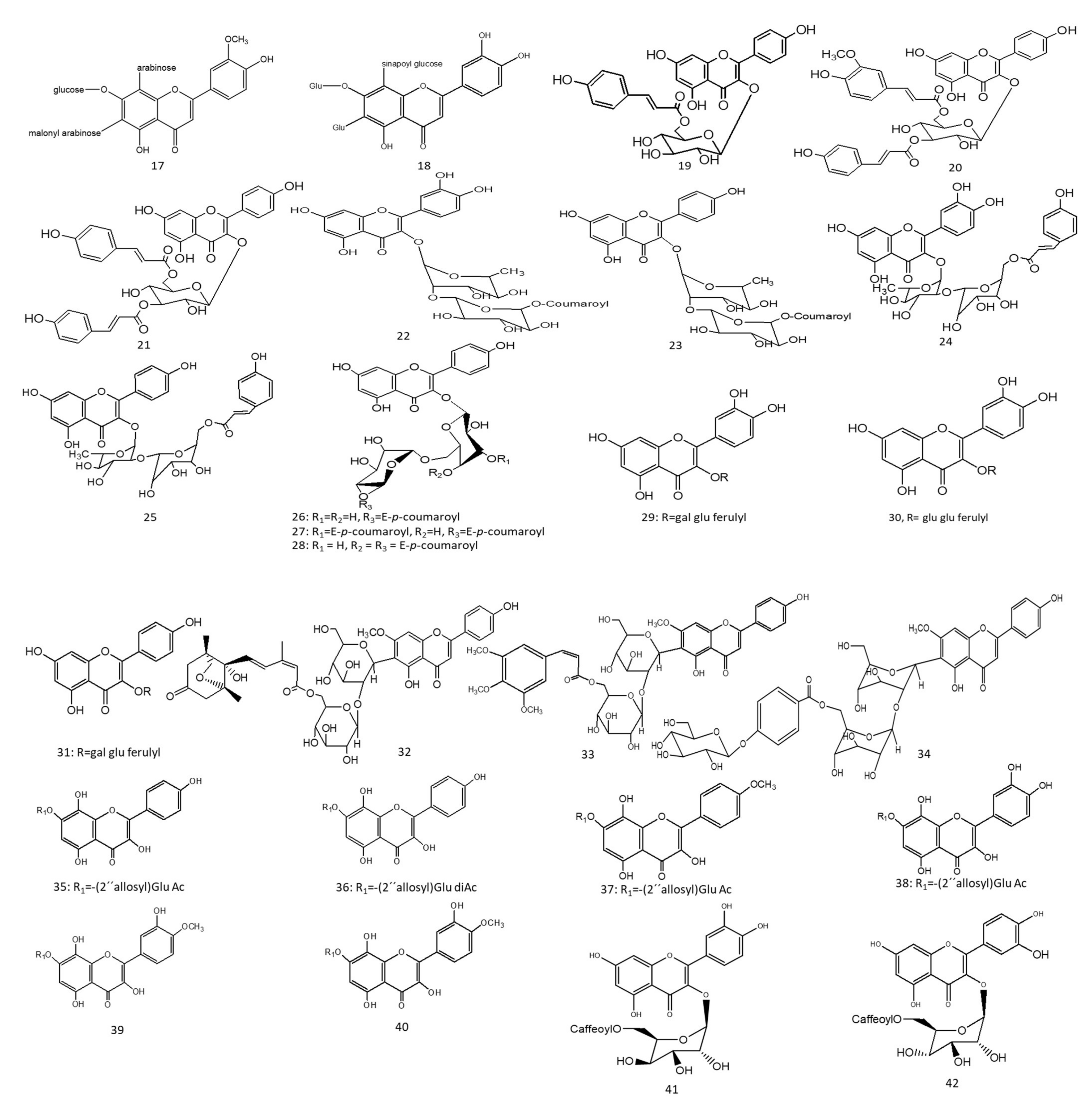
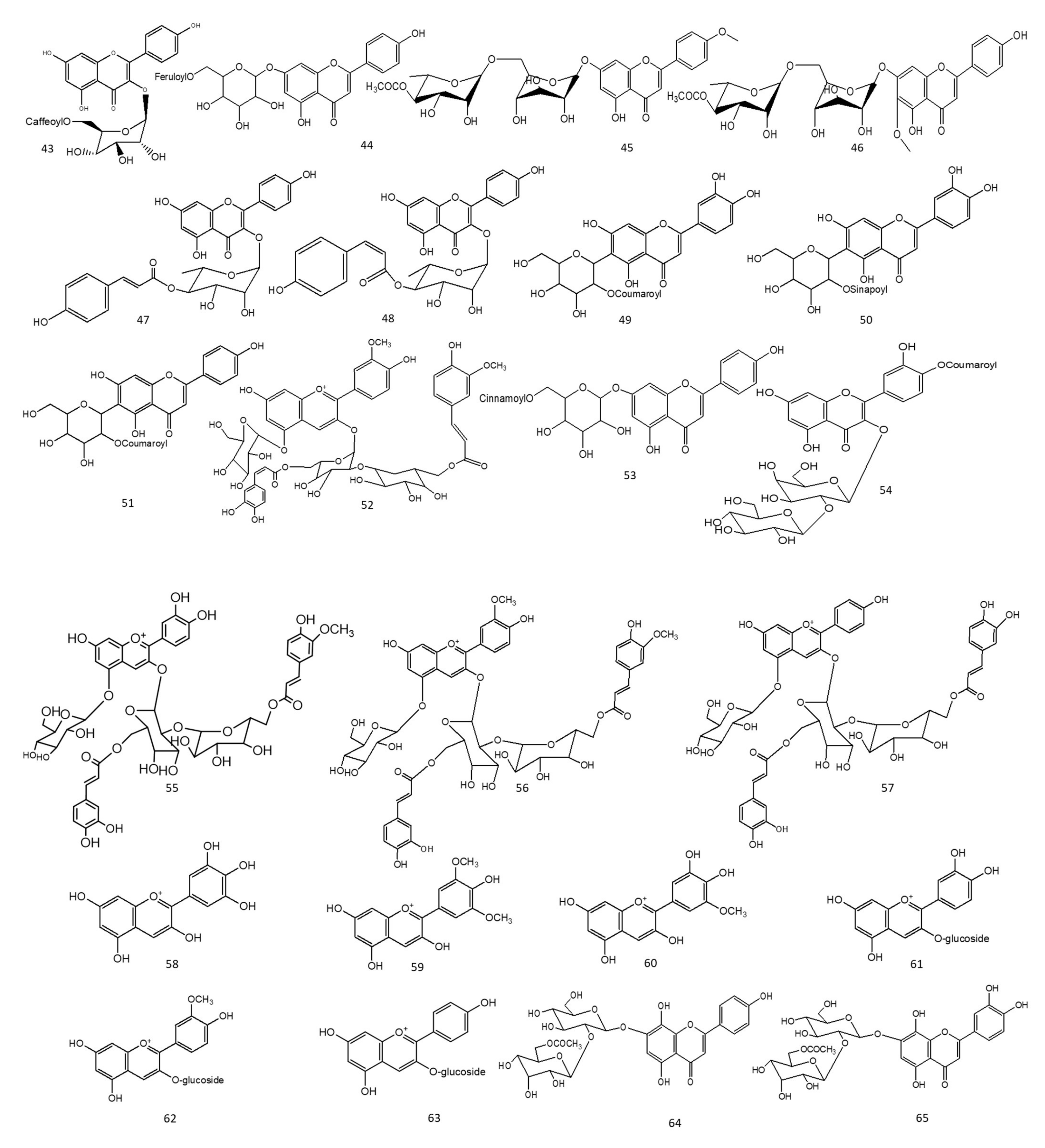
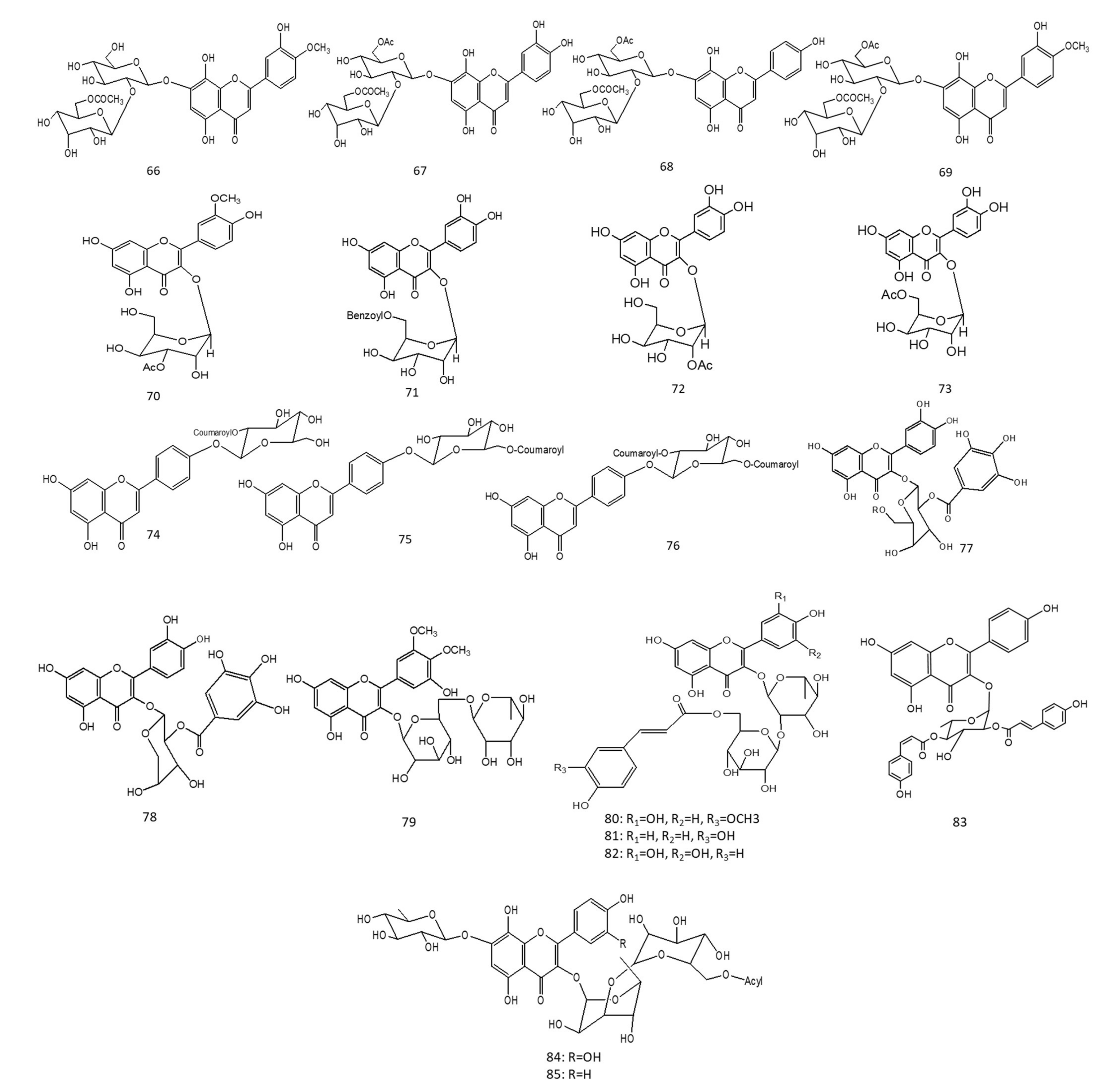
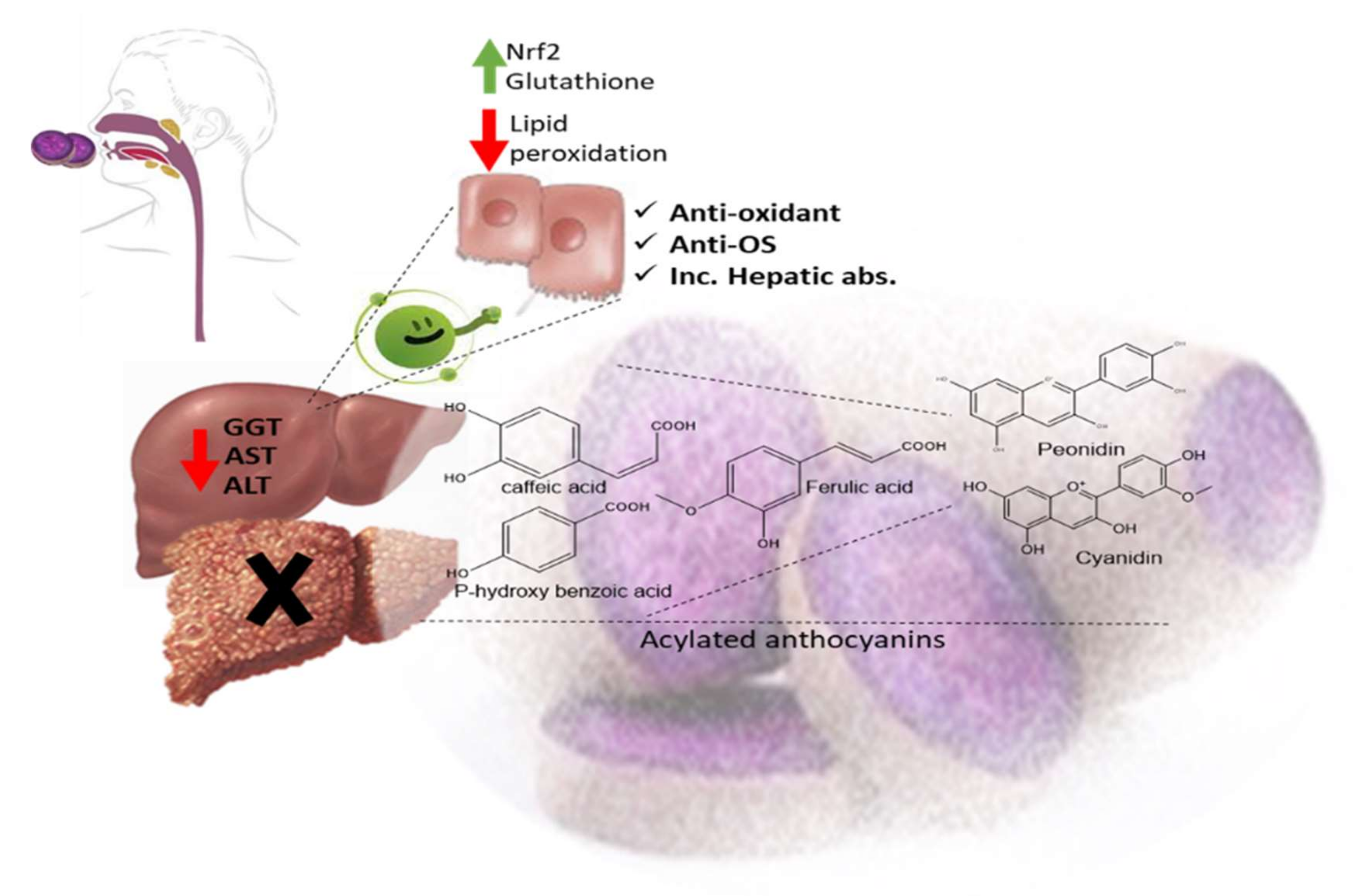
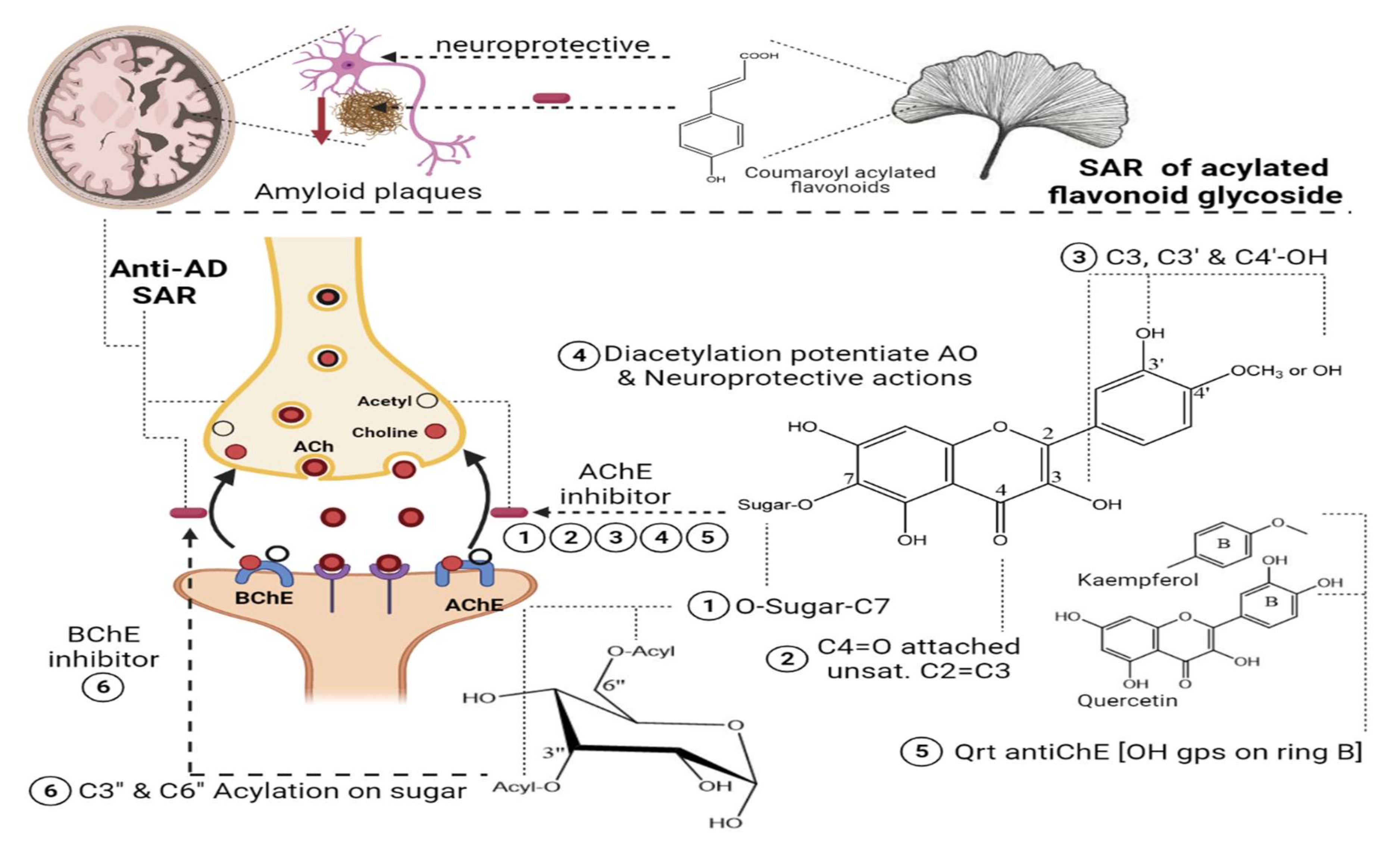

| PDB ID | Enzyme | Co-Crystallized Ligand | RMSD | Docking Score of the Co-Crystallized Ligand (kcal/mol) |
|---|---|---|---|---|
| 4EY7 | Acetylcholinesterase | Donepezil | 0.8427 | −12.7467 |
| 4BDS | Butyrylcholinesterase | Tacrine | 0.4496 | −9.3945 |
| 4W93 | α-amylase | montbretin A | 2.7060 | −32.5225 |
| 2QMJ | α-glucosidase | Acarbose | 0.5016 | −26.2699 |
| 3RX3 | aldose reductase | Sulindac | 1.0574 | −8.9588 |
| 1QS4 | HIV 1 integrase | 1-(5-chloroindol-3-yl)-3-hydroxy-3-(2H-tetrazol-5-yl)-propenone | 0.6840 | −10.2199 |
Publisher’s Note: MDPI stays neutral with regard to jurisdictional claims in published maps and institutional affiliations. |
© 2022 by the authors. Licensee MDPI, Basel, Switzerland. This article is an open access article distributed under the terms and conditions of the Creative Commons Attribution (CC BY) license (https://creativecommons.org/licenses/by/4.0/).
Share and Cite
El-Kersh, D.M.; Abou El-Ezz, R.F.; Fouad, M.; Farag, M.A. Unveiling Natural and Semisynthetic Acylated Flavonoids: Chemistry and Biological Actions in the Context of Molecular Docking. Molecules 2022, 27, 5501. https://doi.org/10.3390/molecules27175501
El-Kersh DM, Abou El-Ezz RF, Fouad M, Farag MA. Unveiling Natural and Semisynthetic Acylated Flavonoids: Chemistry and Biological Actions in the Context of Molecular Docking. Molecules. 2022; 27(17):5501. https://doi.org/10.3390/molecules27175501
Chicago/Turabian StyleEl-Kersh, Dina M., Rania F. Abou El-Ezz, Marwa Fouad, and Mohamed A. Farag. 2022. "Unveiling Natural and Semisynthetic Acylated Flavonoids: Chemistry and Biological Actions in the Context of Molecular Docking" Molecules 27, no. 17: 5501. https://doi.org/10.3390/molecules27175501
APA StyleEl-Kersh, D. M., Abou El-Ezz, R. F., Fouad, M., & Farag, M. A. (2022). Unveiling Natural and Semisynthetic Acylated Flavonoids: Chemistry and Biological Actions in the Context of Molecular Docking. Molecules, 27(17), 5501. https://doi.org/10.3390/molecules27175501






